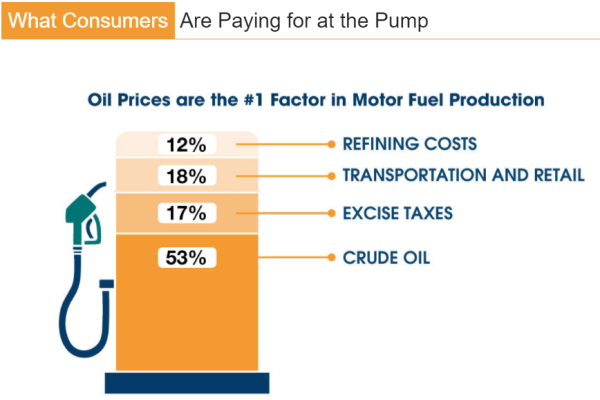Image Pixabay.com [retrieved 1-Dec-2021]
President Biden calls on the Federal Trade Commission to look into whether “illegal conduct” is pushing gas prices up1.
While it makes for good press, he might want to start with his administration –
- canceling the Keystone XL pipeline2,
- suspending drilling leases on federal lands3,
- proposed increase in royalty rates by a reported 50%4,
- proposed higher corporate tax rates5,
- ending our brief period of energy independence6 and
- increasing inflation7.

The largest cost in the of price gasoline is crude oil, an internationally-priced commodity. Its cost has risen to an 8 year high8.
On a gallon of gasoline, the Profit for retailers is 4 cents, producers 8 cents, and the government 40 cents9,10, despite the government having no hand in the creation, delivery, or risk in bringing gasoline to market.
Looked at another way, the Net Profit Margin of retailers is 3%, producers 6.8%, and the government 17%!
The Return on Capital Employed for ExxonMobil is only 4%, for Shell 2%. By comparison, Microsoft’s is 32%! Which business would you rather be in?
Who makes the most off a gallon of gas? The government does, by a lot. Will that be the Biden investigation’s conclusion? Don’t bet on it.
But you can be sure that any extra costs imposed by the Biden administration, as noted in the first paragraph above, will be passed directly to you at the pump.
Additional Reading
Here are just some of the things the federal government is proposing –
- 500% Minimum Bid Increase: Would raise onshore minimum lease bid from $2/acre to $10/acre. By Bureau of Land Management 2020 sales, 11% of leases sold in New Mexico were below $10/acre; 78% in Colorado; and 30% in North Dakota.
- Cuts Time to Produce in Half: Would reduce the primary term for new onshore leases from 10 years to five years, even though a significant percentage of leases require more than five years to start producing. For example, recent data shows that 37% of leases in New Mexico started production more than five years after authorization.
- More Than Doubles Annual Rent: Would raise annual rental rates to $3/acre for the first two years, and then $5/acre, increasing costs by at least $123 million per year.
- Eliminates Possibility of Royalty Relief: Would eliminate authority to grant royalty relief in difficult times or national emergency.
- Imposes New Inspection Fee: Would raise the minimum inspection fees each operator will pay annually to anywhere from $800-$11,300 per lease, varying by lease.
- Increased Royalty Rates: Would raise onshore royalty rate floor by more than half from 12.5% to 20% on new leases and would raise the already high offshore royalty rate floor to 20%.
- New Royalties on Venting/Flaring: Would require royalties to be paid on all gas produced, including gas used or consumed for the benefit of the lease such as gathering compressors and gas that is consumed or lost by venting, flaring, or fugitive releases, with limited exceptions, which would raise royalty payments on average by 6.5%.
- 1500-2000% Bonding Increase: Would increase onshore federal lease bond minimum 15-fold for a federal lease bond, by 20 times for a statewide bond, and removes the nationwide bond option. Additionally, it calls for rulemaking that will require bonding to cover 100% of the reclamation costs of a lease on federal lands that have less than 0.05% of federal wells orphaned.
- New Expression of Interest Fee: Would impose a minimum $15/acre to notify the government of public interest in leasing. Onshore leases can be as large as 2,560 acres, thus costing up to $38,400/lease.
- New “Resource” Fee: Would impose a $4/acre annual fee on producing leases, thus costing up to $10,240/lease for onshore leases, and $23,040/lease for offshore leases.
- New Leasing Fee: Would impose a $6/acre annual fee on non-producing leases, thus costing up to $15,360 for each onshore lease, and $34,560 for each offshore lease.
- New Severance Tax Fee: Would impose a new annual, non-refundable Federal severance fee “tax” on every barrel of oil equivalent produced from new leases on federal lands and waters.
- New Idled Wells Fee: Would impose an annual cost anywhere from $500-$7,500 per idled well per year and would deem a well “nonoperational” after two years, down from seven years.
2 Developer officially cancels Keystone XL pipeline project blocked by Biden
3 Biden administration puts freeze on federal fossil fuel leases and permits
4 Biden to increase oil leasing fees, experts fear costs will increase gas prices
5 President Biden’s Corporate Tax Hike Means Higher Energy Prices for Families and Businesses
6 Biden rings death knell for America’s energy independence
7 Biden Can’t Avoid Blame for Inflation, a Tough Problem to Fix

